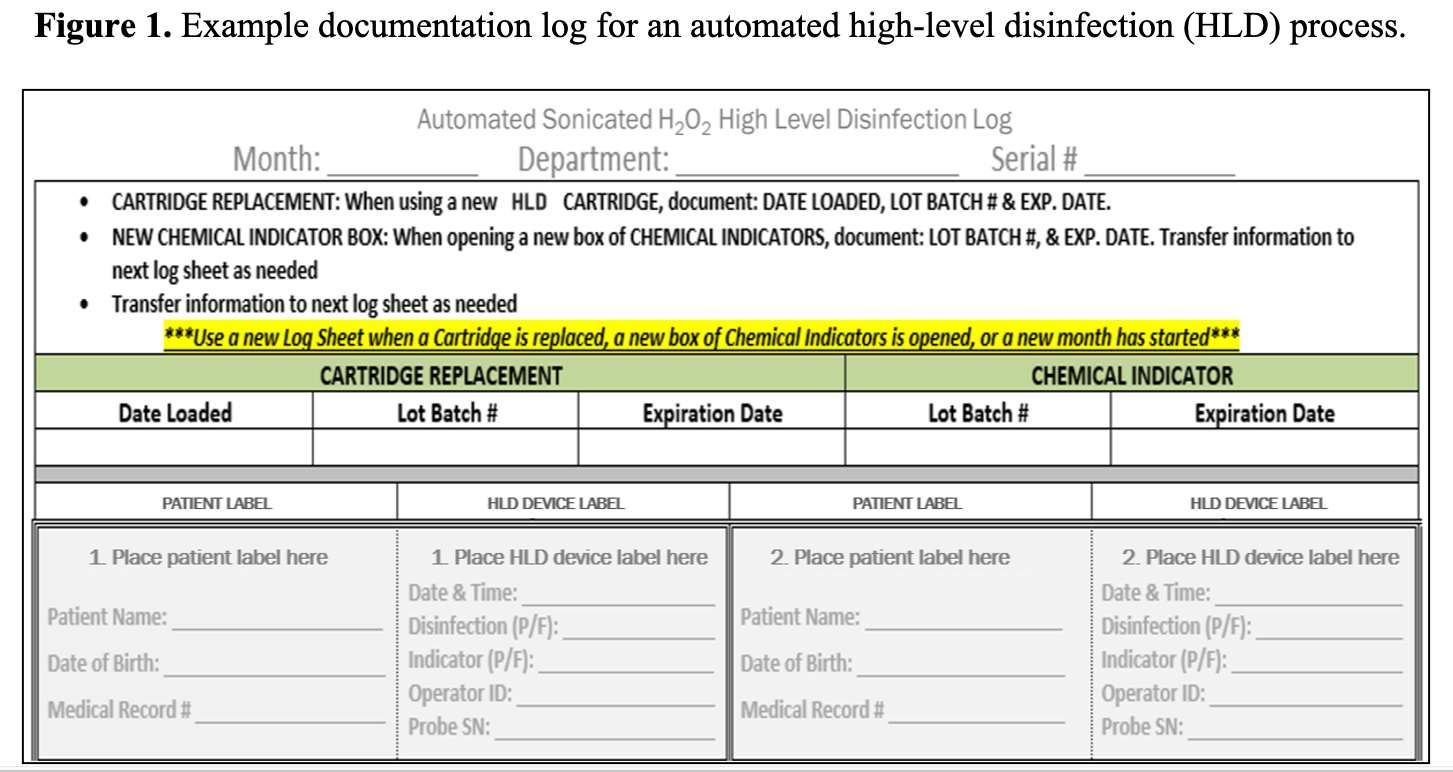How to Document the High-Level Disinfection Patient Connection
The high-level disinfection process of an ultrasound probe, when indicated, includes documentation that demonstrates high-level disinfection was performed, and patient identifiers were documented to link the ultrasound probe to the patient. This is often referred to as traceability.
Here’s the scenario: A patient returns to your hospital after a vaginal ultrasound procedure with an infection. A look-back of this potential health care-associated infection (HAI) includes a review of the vaginal ultrasound probe that was used to perform this patient’s procedure. Can the probe be traced to the patient? Was the probe high-level disinfected based on intended use?
To answer these questions, a health care facility must have standard policies and procedures (P&Ps) in place, procedures that outline the approach to the high-level disinfection process and traceability of a vaginal ultrasound probe (or a surface probe based on intended use). Additionally, knowledge of the 3 definitions outlined in Table 1 should be understood to navigate our scenario. Staff should be trained and retrained to ensure consistent implementation of P&Ps to help ensure patient and staff safety.

Policies and Procedures
An understanding of law and regulation (i.e., the Food and Drug Administration (FDA), the ultrasound probe manufacturer’s instructions for use, and nationally recognized evidence-based guidelines for high-level disinfection. Guidelines from, for example, the Centers for Disease Control and Prevention (CDC), the Association for the Advancement of Medical Instrumentation (AAMI), and the Association of periOperative Registered Nurses (AORN) should be consulted when developing and implementing P&Ps.
FDA’s Role
The FDA regulates the labeling of medical devices such as ultrasound probes and liquid chemical sterilants/high-level disinfectants. The FDA uses the Spaulding Classification System, and here are some examples.
The 2019 FDA document entitled Marketing Clearance of Diagnostic Ultrasound Systems and Transducers. Guidance for Industry and Food and Drug Administration Staff states in Appendix E
Lisa Waldowski, DNP, RN, CIC

Cleaning, Disinfection, and Sterilization that “the probe used in a semi-critical application should be cleaned and undergo sterilization or at least receive high level disinfection after use even if a sheath was used. Sheaths can fail during use, and the level of resulting contamination may not be easily visible.” In the Code of Federal Regulations, Title 21, Chapter I -FDA, it is stated that “a liquid chemical sterilant/high level disinfectant is a germicide that is intended for use as the terminal step in processing critical and semi-critical medical devices prior to patient use. Critical devices make contact with normally sterile tissue or body spaces during use. Semi-critical devices make contact during use with mucous membranes or nonintact skin.”
Inventory Ultrasounds
Having a complete organization-wide inventory and location of all ultrasound probes and their respective ultrasound units is an advised initial approach. This should then be followed by a comprehensive review of all ultrasound probe instructions for use (IFUs). When IFUs are not clear, or information is missing, contacting the manufacturer is recommended. It is important to consult IFUs for compatible disinfection products and other information. For example, one manufacturer IFU states: “When choosing a disinfectant, determine the required level of disinfection based on device classification. If the possibility of cross-contamination or exposure to unhealthy or non-intact skin exists, then high-level disinfection should be performed.” It is important to review the IFUs in their entirety for complete instruction.
Evidence-Based Guidelines
Examples of recommended evidence-based guidelines on high-level disinfection and traceability include those from AAMI and AORN. These documents detail the importance of traceability and information that should be collected and linked to the unique device and patient. They recognize that maintaining high-level disinfection records helps ensure that parameters for correct high-level disinfection have been met, helping manage recalls in potential outbreak situations, and establishing traceability and accountability. For each high-level disinfection cycle, one of the elements that should be recorded and maintained, in addition to the high-level disinfection parameters and unique device, includes the patient’s name and medical record number, if available.
Complete Traceability
The documentation log displayed in Figure 1 is an example log for an automated high-level disinfection (HLD) process. This method incorporates sticking the printed label generated from the automated HLD process in the documentation log-book next to the patient label or sticker. The label generated from the automated HLD process can also include the serial number of the HLD automated unit, the date and time, the HLD cartridge lot number, and expiration date, along with the chemical indicator lot number and expiration date, the operators, and probe. Where this is not available, space in the log can be made available to record this information, as shown in Figure 1. Incorporating the use of automatically generated labels can help save time and reduce the risk of error from manually recording and checking information.

When an ultrasound probe is not compatible with an automated process, as determined by the manufacturer, a manual HLD process may be the recommended method by the manufacturer. To complete documentation, the following needs to be recorded by staff: the HLD product, date processed, lot number, expiration date, temperature, immersion time (time-in and time-out), operator initials, and minimal effective concentration of the test strip used to check the HLD. The test strip used corresponds to the HLD product. The quality monitoring of the test strip, lot number, and expiration date are recorded in the documentation log. Documentation logs for a manual process may be found from the manufacturer of the HLD product for consideration. These key elements are essential to documenting the HLD process of the ultrasound probe, in addition to providing the patient label or sticker to the uniquely identified ultrasound probe to link the probe to the patient. All HLD product and test strip instructions for use should be consulted and followed.
Having one standardized method to complete traceability that links the ultrasound probe that has been high-level disinfected to the patient is best practice in a department and across a facility. A routine review or audit of the documentation components to identify any gaps or omissions is essential to supporting a highly reliable HLD process.
Traceability’s Importance
Traceability in ultrasound probe infection prevention enables facilities to demonstrate at any time that they have met their standard of quality and safe care for their patients. Traceability demonstrates that the facility and its staff are following law and regulation, manufacturer IFUs, and nationally recognized evidence-based guidelines across any department utilizing ultrasound probes that require high-level disinfection based on the intended use.
Traceability information and documentation logs are essential tools for infection preventionists (IPs), department heads, and risk and quality management. From a legal, risk management standpoint, having records that demonstrate P&Ps are being followed by staff helps minimize the risk of an adverse patient safety event, and can help identify potential areas that require staff retraining or improvement. As HLD processes are heavily scrutinized during accreditation or regulatory surveys and remain a top non-compliant scored standard, attention to these elements is advised.
Recommendations
Standardizing ultrasound infection prevention and traceability in a facility helps ensure the safety of patients and fellow staff. It is important to develop and maintain an ultrasound probe inventory with clear identifiers for each device in use. A standard approach should be used to select evidence-based guidelines for P&Ps, and when implementing P&Ps, standardizing high-level disinfection processes across the organization to include documentation is advised.Consider incorporating digitization of documentation into the workflow, if and where available, to minimize manual record-keeping and any associated risk of error. Be knowledgeable and perform oversight, audits, and validation on a routine basis.
Now, back to our scenario: The IP reviewed the documentation log for traceability of the patient in the above scenario. The department that had performed the vaginal ultrasound procedure had complete traceability documentation based on following the guidance above. They were able to demonstrate the probe had undergone HLD successfully before it was used in the vaginal exam on the patient.
Lisa Waldowski, DNP, RN, CIC, is an expert in the field of infection prevention and control with over 30 years of experience in the health care industry. An expert in accreditation and regulatory standards, Waldowski knows how to develop and implement comprehensive infection prevention and control programs. She currently works as a Regional Director in Infection Prevention and Control at Kaiser Permanente. The views expressed in this article are Lisa Waldowski’s, and not Kaiser Permanente’s.
Phage Therapy’s Future: Tackling Antimicrobial Resistance With Precision Viruses
April 24th 2025Bacteriophage therapy presents a promising alternative to antibiotics, especially as antimicrobial resistance continues to increase. Dr. Ran Nir-Paz discusses its potential, challenges, and future applications in this technology.
Robust infectious disease surveillance, including rapid subtyping of influenza A, is essential for early detection, containment, and public health reporting of novel viral threats.